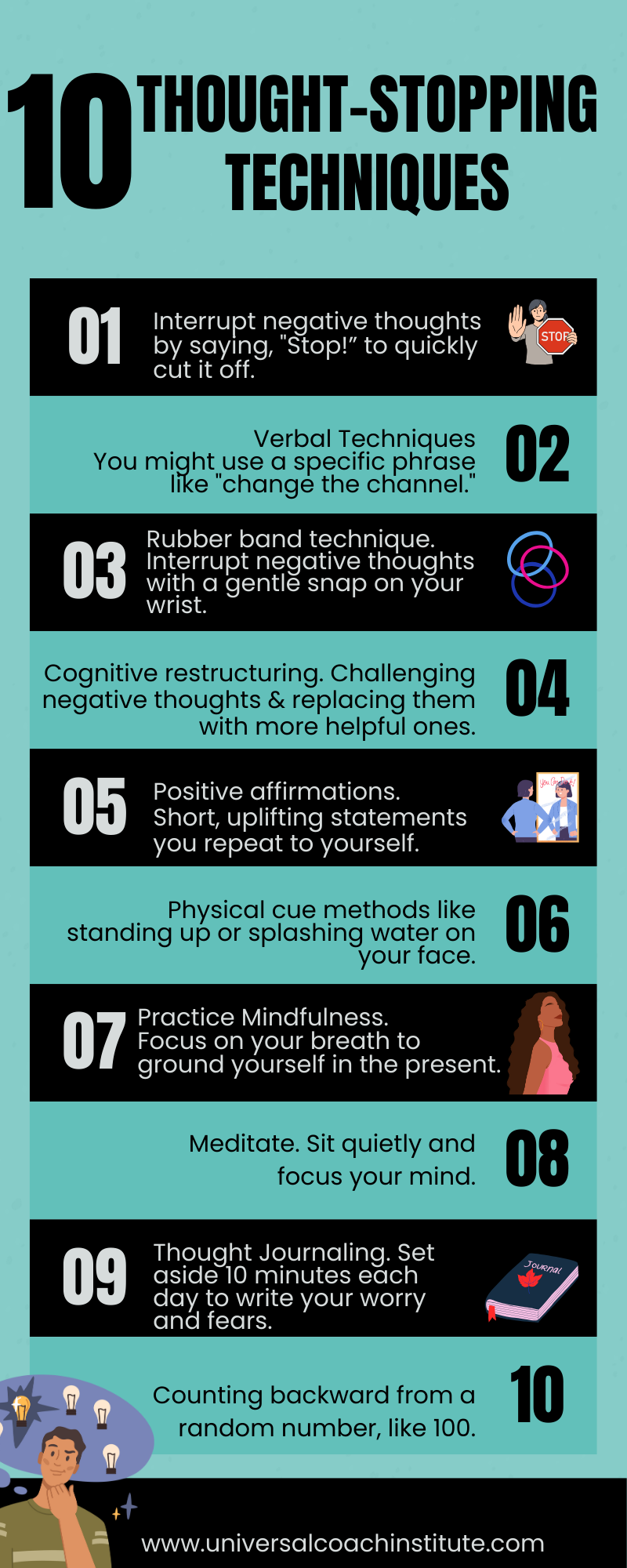Unwanted thoughts can be distressing and disruptive to daily life. Thought stopping techniques offer ways to manage these intrusive mental patterns.
You can learn to control your thoughts and reduce anxiety using simple mental exercises.
These methods will help you break the cycle of negative thinking. They work by shifting your focus away from troubling ideas.
You might wonder, “Do thought-stopping techniques actually work?” While not a one-size-fits-all solution, research shows they can improve well-being when applied correctly.
A study, “Improving mental health by training the suppression of unwanted thoughts,” published in Science Advances by Thomas Anderson et al., proved that suppressing negative thoughts increased well-being.
In This Post
What is Thought Stopping?
Thought-stopping is a technique for interrupting unwanted or negative thoughts. Its goal is to help people gain control over their thinking patterns and reduce anxiety.
Thought-stopping can help deal with worries, self-doubt, or recurring negative ideas. By blocking these thoughts, you can replace them with more positive or realistic ones.
History of Thought Stopping
Thought-stopping was first developed in the 1950s by a South African psychiatrist, Joseph Wolpe. He used it as part of his behavior therapy work on systematic desensitization to help patients with anxiety and phobias.
Wolpe’s work, as outlined in his book Psychotherapy by Reciprocal Inhibition, demonstrated that interrupting anxiety-provoking thoughts could help patients desensitize themselves.
This concept also influenced Albert Ellis’s Rational Emotive Behavior Therapy (REBT), which emphasized challenging irrational thoughts.
By the 1970s, thought-stopping gained popularity for treating a broader range of issues, including depression and obsessive thoughts. Over time, it has become integral to many cognitive-behavioral therapy (CBT) approaches.
Myths and Misconceptions
- It works instantly: Incorrect. Thought-stopping requires practice to become effective.
- It gets rid of thoughts forever: A myth. It’s a temporary tool to refocus, not a permanent fix.
- It’s the same as thought suppression: They’re different. Suppression tries to push thoughts away completely, which can lead to a rebound effect. Thought-stopping interrupts and redirects thoughts instead.
- It works for everyone: Not true. While helpful for many, it may not suit all people or situations.
- It suppresses the root cause of anxiety: This misconception overlooks that thought-stopping is a short-term tool meant to complement deeper strategies.
How Thought Stopping Works?”
A study titled “The Thought Stopping Procedure: Description, Application, and Learning Theory Interpretations,” published in the Psychological Record by Cautela and Wiskocki, describes how thought-stopping works by first recognizing the negative thought when it occurs.
Then, you use a trigger to interrupt repetitive negative loops, like saying ‘stop’ out loud or visualizing a red light.
These deliberate cues help break the rumination cycle and redirect your focus.
This can be saying “stop” out loud or snapping a rubber band on your wrist.
After stopping the thought, you replace it with a positive one. You might use an affirmation or visualize a calming scene.
The goal is to break the cycle of negative thinking.
To use thought-stopping:
- Identify the unwanted thought.
- Use your chosen “stop” signal.
- Shift to a positive thought or activity.
At first, you may need to use the technique often. Over time, unwanted thoughts should decrease. Some find it helpful to keep a log of their progress.
Thought-stopping works by creating new mental habits. You train your brain to recognize and interrupt negative patterns.
When to Use Thought Stopping?
Thought-stopping can be useful in many situations, including:
- Anxious thoughts
- Self-doubt
- Rumination
- Intrusive memories
- Unwanted urges
- Obsessive ideas
Imagine you’re preparing for an important meeting, and self-doubt arises.
Notice the thought, say ‘stop’ firmly in your mind, and replace it with a calming affirmation like, ‘I’ve prepared well for this.’
This process helps redirect focus in the moment.
Identifying Unhelpful Thoughts
Recognizing negative thought patterns is a key step in managing your mental well-being. By spotting problematic thoughts early, you can take steps to address them effectively.
Awareness of Thought Patterns
Pay attention to your inner dialogue.
For example, if you frequently think, “I’ll never get this right,” it may signal a pattern of overgeneralization. Recognizing such themes early helps you disrupt them before they grow stronger.
Types of Problematic Thoughts
Unhelpful thoughts often stem from cognitive distortions—patterns of negative thinking first identified by Aaron Beck, such as:
- All-or-nothing thinking: Seeing things as only good or bad.
- Overgeneralization: Applying one negative experience to all situations.
- Catastrophizing: Assuming the worst possible outcome.
- Mind reading: Believing you know what others are thinking.
- Emotional reasoning: Thinking your feelings are facts.
By identifying and addressing these cognitive distortions, you can reduce their impact and adopt healthier mental habits.
10 Thought Stopping Techniques
Thought-stopping techniques use specific actions to interrupt and redirect negative thinking patterns. These methods can help you gain control over unwanted thoughts.
1. Interruption of Negative Thoughts
When a negative thought arises, you quickly cut it off by saying, “Stop.” This interruption breaks the cycle of rumination.
According to a study titled “The Thought Stopping Procedure: Description, Application, and Learning Theory Interpretations” by Cautela and Wisocki, this technique effectively reduces the frequency of distressing thoughts over time.
You can say “stop” out loud or in your head. Another option is to visualize a stop sign or red light.
To practice, set aside 10 minutes daily. Let negative thoughts come, then stop them. Repeat this process to build the skill.
2. Verbal and Auditory Techniques
Words and sounds can help stop unwanted thoughts. You might use a specific phrase like “not now” or “change the channel.”
Research by Makram Samaan titled “Thought-stopping and flooding in a case of hallucinations, obsessions, and homicidal-suicidal behavior” supports the use of verbal cues as effective tools for managing intrusive thoughts.
You can also try using a noise. Clap your hands, ring a bell, or play a sound on your phone. The key is to use the same cue each time.
3. Physical Cue Methods
Physical actions can snap you out of negative thinking. Try these:
- Stand up quickly
- Splash cold water on your face
- Do 10 jumping jacks
These actions create a physical break from the thought pattern. They also shift your focus to your body and surroundings.
Pick a method that feels natural to you. Practice it often to make it a habit.
4. Cognitive Restructuring
Cognitive restructuring is a Cognitive Behavioral Therapy (CBT) technique. It challenges negative thoughts and replaces them with more helpful ones.
In cognitive restructuring, you question the truth of your thoughts.
According to Aaron T. Beck, founder of CBT, this process involves identifying automatic negative thoughts and evaluating their validity. Beck emphasized that these thoughts are often distorted and not based on evidence, yet they significantly influence emotions and behaviors.
Challenge thoughts by asking, “What proof supports this?” or “Am I overgeneralizing?”
Beck’s work highlights that such questions encourage mental flexibility and counteract distortions like catastrophizing, which involves assuming the worst possible outcome.
Then, replace it with a more helpful thought.
Try catching negative self-talk throughout your day. Write down what you’re thinking. Then, come up with a more positive way to frame it. With practice, this gets easier.
5. Creating Positive Affirmations
Positive affirmations are short, uplifting statements you repeat to yourself. They help rewire your brain to focus on your strengths and possibilities.
To make affirmations:
- Use present tense (“I am” not “I will be”)
- Keep them short and specific
- Make them personal and meaningful to you
Examples:
- “I am capable and strong.”
- “I learn from my mistakes and grow.”
- “I choose to focus on the good in my life.”
Say your affirmations out loud daily.
Start with 2-3 affirmations. Repeat them in the morning or before bed. You can also write them down or set reminders on your phone.
6. Rubber Band Technique
The rubber band technique interrupts negative thoughts with a gentle snap on your wrist. This physical cue redirects focus and signals the need to replace the thought with something constructive.
For example, if you catch yourself thinking, “I can’t handle this,” snap the rubber band and replace it with, “I’m taking it one step at a time.”
According to Cautela and Wisocki’s study, physical cues like this can help disrupt negative thought patterns.
Over time, this technique can help you become more aware of your thoughts and train your mind to respond in healthier ways.
7. Mindfulness Techniques
Mindfulness involves focusing on your breath or sensations to ground yourself in the present.
For example, during stressful moments, take 10 deep breaths, noticing how the air feels entering and leaving your nose.
When your mind wanders, bring your focus back without judgment.
Research on neuroplasticity titled “Neurobiological Changes Induced by Mindfulness and Meditation: A Systematic Review,” published in Biomedicines (2024), shows that consistent mindfulness practice can reshape brain areas like the prefrontal cortex, enhancing emotional regulation.
8. Meditation
Meditation involves sitting quietly and focusing your mind. It can reduce stress and boost your mood.
You might try guided meditation using an app or video.
Or you can sit quietly and repeat a calming word or phrase. Even 5-10 minutes of meditation per day can make a difference.
Meditation takes practice. Don’t get frustrated if your mind wanders at first. With time, it will become easier to quiet your thoughts.
9. Thought Journaling
Thought journaling is a powerful way to stop negative thoughts and manage stress. It helps you put your feelings on paper and gain a new outlook.
A thought journal is a place to write down your worries and fears. You can use a notebook or your phone to record thoughts as they come up. This helps you spot patterns in your thinking.
Try setting aside 10-15 minutes each day to write. Don’t worry about spelling or grammar – just let your thoughts flow. As you write, you might notice your anxiety start to lessen.
10. Counting Backwards
Counting backward from a random number, like 100 in intervals of three, distracts your mind from intrusive thoughts and grounds you in the present.
10 Thought Stopping Coaching Techniques
As a therapist or coach, you can use coaching techniques to guide clients in mastering thought-stopping techniques by tailoring them to individual needs and goals.
Start by helping clients recognize and track negative thought patterns. Then, teach them methods to disrupt these patterns effectively. Lastly, focus on actionable steps, such as creating daily routines or combining thought-stopping with goal-setting strategies, to help clients build consistency and confidence in managing their thoughts.
Here are advanced coaching techniques a coach can use to help clients in managing intrusive thoughts:
- Visualization Technique: Guide clients to imagine a stop sign or a calming scene to disrupt negative thought patterns.
- Questioning Technique: Help clients challenge thoughts by asking, “Is this true?” or “What evidence supports or contradicts this?”
- Habitual Reframing: Teach clients to replace negative thoughts with balanced alternatives, like swapping “I’ll fail” for “I’m learning and improving.”
- Reality Testing: Encourage clients to compare their thoughts against facts by evaluating evidence for and against their beliefs.
- Cognitive Defusion: Help clients detach from their thoughts by visualizing them as leaves floating down a stream.
- Downward Arrow Technique: Assist clients in uncovering deeper beliefs by asking, “Why does this matter?” repeatedly.
- Socratic Questioning: Use reflective prompts like, “What would you say to a friend in this situation?” to help clients gain perspective.
- The “Observer Perspective”: Encourage clients to view their thoughts from a distance, as if they’re an outside observer.
- The “What If” Reframe: Shift negative “what if” scenarios to positive ones, like changing “What if I fail?” to “What if I succeed?”
- Labeling the Thought: Encourage clients to name their thoughts, like “This is anxiety,” to create distance and reduce their impact.
These coaching techniques provide clients with practical, powerful tools to stop intrusive thoughts and develop greater mental clarity.
Thought Stopping Worksheets
- Thought Record (Canva)
- Thought Cloud (Canva)
- Reframing Negative Thoughts (Canva)
- Cognitive Shifting Through Sensory Anchors
- Stop and Swap Technique
- Progressive Thought Reduction
- Visualization and Dissociation
- Values-Oriented Distraction
Frequently Asked Questions
How to stop anxiety thoughts naturally?
Say ‘stop’ firmly in your mind or visualize a stop sign. Follow up with 5 deep breaths or a sensory grounding technique, like focusing on the feel of your clothes or the sounds around you.
Alternatively, snap a rubber band on your wrist for a physical reminder to shift your focus.
Scheduling a 15-minute “worry time” can also help contain anxious thoughts.
How to stop rumination?
Try the “worry jar” technique—write down recurring thoughts, put them in a jar, and set them aside. Distract yourself with an activity like a puzzle or a walk. Challenge your thoughts by asking, “Is this helpful?” or “What advice would I give a friend?”
How to stop self-doubt in decision-making?
Use the “pro-con” method to weigh your options or imagine advice from your future self to gain perspective. Build confidence by listing past decisions you made successfully.
How to stop angry thoughts?
Count slowly from 1 to 10 to calm down before reacting. Use positive self-talk, like “I can handle this calmly,” or replace angry thoughts with a peaceful image, such as a serene beach or forest.
What are the best practices for how to stop negative thoughts?
Build a Routine
Set aside 10-15 minutes daily to practice thought-stopping. Use a quiet space, start with deep breaths, and stay consistent. Track your progress in a journal to identify triggers and effective methods.
Combine Techniques
Mix visualization, self-talk, distractions, and deep breathing for a layered approach. For example:
- Picture a stop sign.
- Say a positive phrase.
- Do a brief activity.
- Take 5 calming breaths.
- Experiment to find what works best for you.
Tailor to Your Needs
Choose techniques that suit your lifestyle and personality. On-the-go? Try snapping a rubber band. For future worries, use mindfulness. Logical thinkers might prefer fact-checking their thoughts.
Commit for the Long Term
Practice consistently for 6-8 weeks to see results. Be patient, track your mood, and celebrate small wins to stay motivated.
What are the potential drawbacks of thought-stopping techniques?
Trying to stop unwanted thoughts might make them pop up more often, which can feel frustrating and increase worry.
Some people find thought-stopping difficult or stressful, and it may not address the root cause of their concerns.
Thought-stopping is less effective for severe anxiety or OCD, and relying only on it could prevent you from seeking better help.
What should I do if thought-stopping doesn’t work?
If thought-stopping isn’t working after a few weeks, consider talking to a therapist or trained coach.
Seek help immediately if you have thoughts of harming yourself or others.
Support and Resources
A therapist or coach trained in CBT can help with thought-stopping. Many offer in-person or online sessions.
Complement thought-stopping with tools like grounding techniques (e.g., holding an ice cube) or guided apps like Calm for mindfulness.
Books such as Feeling Good by Dr. David Burns provide CBT-based methods to reframe unhelpful thinking.
Conclusion
Unwanted thoughts don’t have to control the narrative.
For individuals, thought-stopping techniques are powerful tools to regain focus and calm your mind. With patience and practice, these strategies can help you build resilience and take charge of your thought patterns.
For professionals, guiding clients through these methods provides them with practical, actionable steps to manage intrusive thoughts.
By tailoring techniques to their unique needs and offering consistent support, you empower them to transform how they approach their mental well-being.




